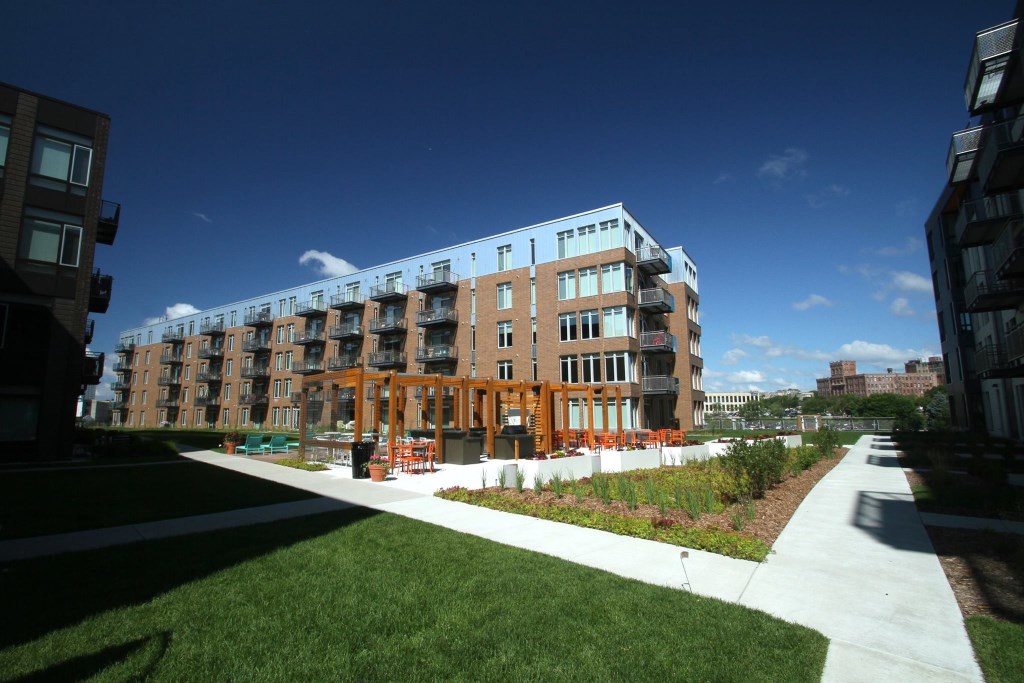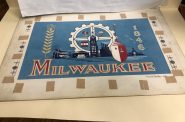City Announces Green Infrastructure Plan
Big changes to adapt to climate change and increase in damaging rainstorms.

This green roof at The North End is one example of green infrastructure that helps to capture rainwater. Photo from Hanging Gardens Facebook page.
We are living in an era of early climate change and the City of Milwaukee is trying to adapt.
Mayor Tom Barrett held a press conference Wednesday announcing the city’s new Green Infrastructure plan framework, after it was adopted by the Milwaukee Common Council Tuesday.
The plan sets out a series of goals for the next year to change the regulatory framework in the city to substantially increase use of green infrastructure in order to capture greater amounts of stormwater and make development more sustainable as Milwaukee and the state continue to get warmer and wetter as a result of global climate change.
The vast majority of climate modeling for the State of Wisconsin predicts this future. A powerpoint released by Michael Notaro an associate climate scientist with the Center for Climate Research at UW-Madison states that the modeling points to a future Wisconsin with “more frequent heavy precipitation events.”
In 2010, a flooding task force called for more comprehensive and sustainable stormwater plans and in 2013 the Milwaukee Metropolitan Sewerage District called for an additional 735 million gallons of stormwater capacity by 2035.
“To address the risk and the realist of climate change, we need to make sure that our policies align with our goals,” Barrett said.
This is where green infrastructure can play a role. Since 2002, roughly 36 million gallons of green infrastructure has been added in the city. The mayor’s new green infrastructure framework is part of the city’s climate adaptation plan as laid out by the Environmental Collaboration Office. And as Kevin Shafer, executive director of MMSD said, “Green infrastructure is just one element, it won’t do everything that we want it to do. We’ll have to marry that with some of the other initiatives.”
What the mayor has proposed, with support of the council, will be a systematic change to green infrastructure policy in the city. A big part of this will be new regulatory mechanisms to require developers to design properties that capture the first half-inch of stormwater in green infrastructure on all properties of an acre or more, or whenever a stormwater management plan is required. It also lowers the regulatory requirement that triggers the necessity for a stormwater management plan from one-half acre of impervious surface area to .12 acres of impervious surface area on a project.
To nudge residents in the right direction, the city will be providing one-time grants to property owners to help defray the costs of installing green infrastructure. And in a big step, the city is partnering with Milwaukee Public Schools to redevelop blacktop schoolyards into functional green space and learning environments. Under the plan four to five schoolyards will be redeveloped each year. “Not only does this directly benefit the environment, it directly benefits our students,” Barrett said.
The school yard piece of the project adds a pleasant, kids-friendly layer to this proposal, which is ultimately a small component of a major American city’s attempt to adapt to a future global climate that is quickly making our current urban environment unsustainable and dangerous.
If you think stories like this are important, become a member of Urban Milwaukee and help support real independent journalism. Plus you get some cool added benefits, all detailed here.
Political Contributions Tracker
Displaying political contributions between people mentioned in this story. Learn more.
- December 1, 2020 - Tom Barrett received $500 from Kevin Shafer
- April 1, 2018 - Tom Barrett received $400 from Kevin Shafer
- December 15, 2017 - Tom Barrett received $400 from Kevin Shafer
- October 14, 2015 - Tom Barrett received $400 from Kevin Shafer
City Hall
-
Council Blocked In Fight To Oversee Top City Officials
 Dec 16th, 2025 by Jeramey Jannene
Dec 16th, 2025 by Jeramey Jannene
-
Latest Effort to Adopt New Milwaukee Flag Going Nowhere
 Dec 3rd, 2025 by Jeramey Jannene
Dec 3rd, 2025 by Jeramey Jannene
-
After Deadly May Fire, Milwaukee Adds New Safety Requirements
 Dec 2nd, 2025 by Jeramey Jannene
Dec 2nd, 2025 by Jeramey Jannene






















Cities across the nation and around the world are embracing the Garden as Green Space as a way to increase community, resiliency and livability. Are you willing to help Milwaukee’s green spaces take a big step forward?
Since its formal inception in the spring of 2016 Friends of Milwaukee’s Downtown Forest (FMDF) has presented our Vision, Mission and Aims (VMA) to multiple stakeholders with deep interest in the future of Milwaukee. The VMA has found widespread acceptance as a concept and for Plan C sites, but has not found support for Plan A or Plan B sites.
Recently, we learned that the Plan A site, officially 320 E Ogden or Plot 22 of the Downtown Development Plan, has been withdrawn from the developer and a new RFP for the site will by offered by Milwaukee County. FMDF now seeks partners in developing this RFP. We will not have the details until late September 2018. We will have 30 days after that to prepare the final document for the RFP. We know we can’t do this alone so we are asking your support.
In Good Food, Strong Communities edited by Steve Ventura and Martin Baikley note that change in our food system can occur through “collective impact for change that occurs from many people and organizations working on many aspects of a multifaceted issue” (p.16).
Are you ready to add to the collective impact needed for a resilient food system in Milwaukee:
“A common agenda for change shared by all participants
Shared measurement systems agreed upon buy all
Mutually reinforcing activities performed by specific participants under a guiding overall plan
Continual communication among all participants to share information, report on progress or challenges, and develop mutual shared trust
A separate organization acting as the backbone for the entire initiative?” (p.17)
Are you willing to add your expertise and or/ the expertise of your organization to the development of this project. If so, please message Barbara on Friends of Milwaukee’s Downtown Forest Facebook page: https://www.facebook.com/groups/538772856327700/